Research on Electric Vehicle Electromagnetic Protection Considering Radiation of Two Wireless Chargers
Abstract
:1. Introduction
2. Establishment of Simulation Model
2.1. Global Model and Finite Element Discrete Model
2.2. MCR Wireless Charger Model
2.3. Car Body Model
2.4. Human Body Model
3. Analysis of Simulation Results
3.1. B Value of Wireless Charger A Working Alone and Two Wireless Chargers Working Simultaneously
3.2. Simulation Space B under Different Positions of Two Wireless Chargers
3.3. Influence of Different Car Body Materials
3.4. Electromagnetic Exposure of Driver’s Body under New Measures
4. Conclusions
Author Contributions
Funding
Institutional Review Board Statement
Informed Consent Statement
Data Availability Statement
Conflicts of Interest
References
- Citroni, R.; Di Paolo, F.; Livreri, P. A Novel Energy Harvester for Powering Small UAVs: Performance Analysis, Model Validation and Flight Results. Sensors 2019, 19, 1771. [Google Scholar] [CrossRef] [PubMed] [Green Version]
- Elsisi, M. Optimal Design of Nonlinear Model Predictive Controller Based on New Modified Multitracker Optimization Algorithm. Int. J. Intell. Syst. 2020, 35, 1857–1878. [Google Scholar] [CrossRef]
- Elsisi, M.; Ebrahim, M. Optimal Design of Low Computational Burden Model Predictive Control Based on SSDA towards Autonomous Vehicle under Vision Dynamics. Int. J. Intell. Syst. 2021, 36, 6968–6981. [Google Scholar] [CrossRef]
- Zhang, Z.; Pang, H.; Georgiadis, A.; Cecati, C. Wireless Power Transfer—An Overview. IEEE Trans. Ind. Electron. 2019, 66, 1044–1058. [Google Scholar] [CrossRef]
- Machura, P.; Santis, V.D.; Li, Q. Driving Range of Electric Vehicles Charged by Wireless Power Transfer. IEEE Trans. Veh. Technol. 2020, 69, 5968–5982. [Google Scholar] [CrossRef]
- Arduino, A.; Bottauscio, O.; Chiampi, M.; Giaccone, L.; Liorni, I.; Kuster, N.; Zilberti, L.; Zucca, M. Accuracy Assessment of Numerical Dosimetry for the Evaluation of Human Exposure to Electric Vehicle Inductive Charging Systems. IEEE Trans. Electromagn. Compat. 2020, 62, 1939–1950. [Google Scholar] [CrossRef]
- Chung, Y.D.; Park, E.Y.; Lee, W.S.; Lee, J.Y. Impact Investigations and Characteristics by Strong Electromagnetic Field of Wireless Power Charging System for Electric Vehicle Under Air and Water Exposure Indexes. IEEE Trans. Appl. Supercond. 2018, 28, 1–5. [Google Scholar] [CrossRef]
- Wang, Q.; Li, W.; Kang, J.; Wang, Y. Electromagnetic Safety Evaluation and Protection Methods for a Wireless Charging System in an Electric Vehicle. IEEE Trans. Electromagn. Compat. 2019, 61, 1914–1925. [Google Scholar] [CrossRef]
- Santis, V.D.; Giaccone, L.; Freschi, F. Influence of Posture and Coil Position on the Safety of a WPT System While Recharging a Compact EV. Energies 2021, 14, 7248. [Google Scholar] [CrossRef]
- He, Y.Q.; Leung, P.S.W. The Effect of Static Magnetic Field Exposure to Drivers Cognitive Ability. In Proceedings of the 2019 Joint International Symposium on Electromagnetic Compatibility, Sapporo and Asia-Pacific International Symposium on Electromagnetic Compatibility, Sapporo, Japan, 3–7 June 2019. [Google Scholar]
- Santis, V.D.; Giaccone, L.; Freschi, F. Chassis Influence on the Exposure Assessment of a Compact EV during WPT Recharging Operations. Magnetochemistry 2021, 7, 25. [Google Scholar] [CrossRef]
- Campi, T.; Cruciani, S.; Santis, V.D.; Maradei, F.; Feliziani, M. Magnetic Field Behavior in a Carbon-Fiber Electrical Vehicle Charged by a Wireless Power Transfer System. In Proceedings of the 2017 International Symposium on Electromagnetic Compatibility—EMC EUROPE, Angers, France, 4–7 September 2017. [Google Scholar]
- Li, J.; Yin, F.; Wang, L. Transmission Efficiency of Different Shielding Structures in Wireless Power Transfer Systems for Electric Vehicles. CSEE J. Power Energy Syst. 2021, 7, 1247–1255. [Google Scholar]
- Lu, C.; Rong, C.; Huang, X.; Hu, Z.; Tao, X.; Wang, S.; Chen, J.; Liu, M. Investigation of Negative and Near-Zero Permeability Metamaterials for Increased Efficiency and Reduced Electromagnetic Field Leakage in a Wireless Power Transfer System. IEEE Trans. Electromagn. Compat. 2019, 61, 1438–1466. [Google Scholar] [CrossRef]
- Cruciani, S.; Campi, T.; Maradei, F.; Feliziani, M. Active Shielding Design and Optimization of a Wireless Power Transfer (WPT) System for Automotive. Energies 2020, 13, 5575. [Google Scholar] [CrossRef]
- Bima, M.E.; Bhattacharya, I.; Hasan, S.R. Comparative Analysis of Magnetic Materials, Coil Structures and Shielding Materials for Efficient Wireless Power Transfer. In Proceedings of the 2019 IEEE International Symposium on Electromagnetic Compatibility, Signal and Power Integrity, New Orleans, LA, USA, 22–26 July 2019. [Google Scholar]
- Hwang, Y.J.; Jang, J.Y. Design and Analysis of a Novel Magnetic Coupler of an In-Wheel Wireless Power Transfer System for Electric Vehicles. Energies 2020, 13, 332. [Google Scholar] [CrossRef] [Green Version]
- Vaka, R.; Keshri, R.K. Evaluation and Selection of Shielding Methods for Wireless Charging of E-Rickshaw. Electr. Eng. 2020, 102, 1005–1019. [Google Scholar] [CrossRef]
- Tan, L.; Elnail KE, I.; Ju, M.; Huang, X. Comparative Analysis and Design of the Shielding Techniques in WPT Systems for Charging EVs. Energies 2019, 12, 2115. [Google Scholar] [CrossRef] [Green Version]
- Watanabe, T.; Hakuta, Y. Evaluation of the Magnetic Field Leakage from Two Wireless Power Transfer Systems for EV/PHV Driven Simultaneously. World Electr. Veh. J. 2019, 10, 41. [Google Scholar] [CrossRef] [Green Version]
- Mou, W.; Lu, M. Dosimetry Simulation Research on Electromagnetic Exposure of Wireless Charging Electric Vehicle to Human Central Nervous System. In Proceedings of the 16th IEEE Conference on Industrial Electronics and Applications, ICIEA 2021, Chengdu, China, 1 August 2021. [Google Scholar]
- Miwa, K.; Takenaka, T.; Hirata, A. Electromagnetic Dosimetry and Compliance for Wireless Power Transfer Systems in Vehicles. IEEE Trans. Electromagn. Compat. 2019, 61, 2024–2030. [Google Scholar] [CrossRef]
- Lu, M.; Ueno, S. Comparison of the Induced Fields Using Different Coil Configurations During Deep Transcranial Magnetic Stimulation. PLoS ONE 2017, 12, e0178422. [Google Scholar] [CrossRef]
- Yang, C.; Lu, M. Safety Evaluation for a High Signal Operator with Electric Field Exposure Induced by Contact Wires. Arch. Electr. Eng. 2021, 70, 431–444. [Google Scholar]
- ICNIRP. Guidelines for Limiting Exposure to Time-Varying Electric and Magnetic Fields (1 Hz to 100 kHz). Health Phys. 2010, 99, 818–836. [Google Scholar] [CrossRef] [PubMed]
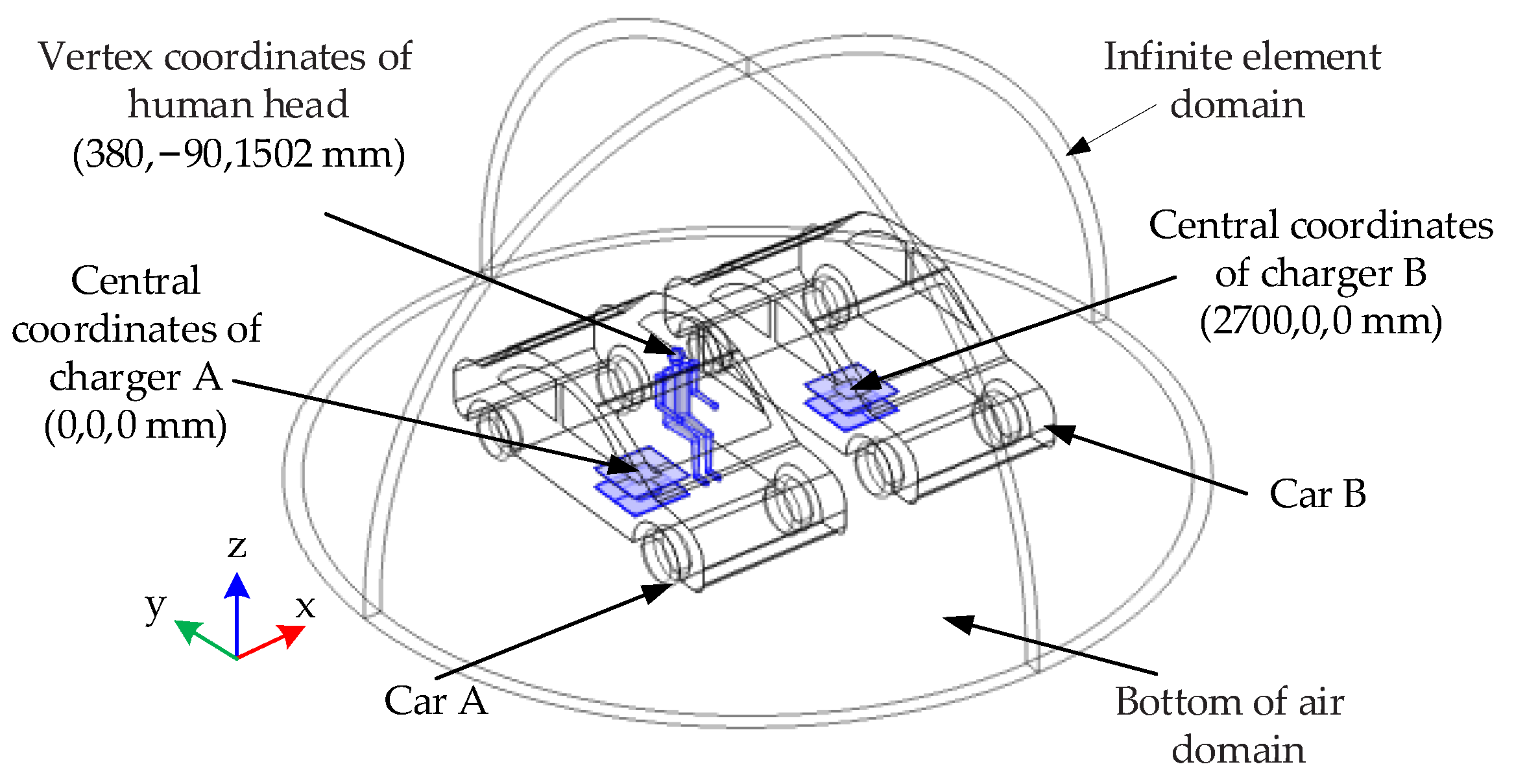
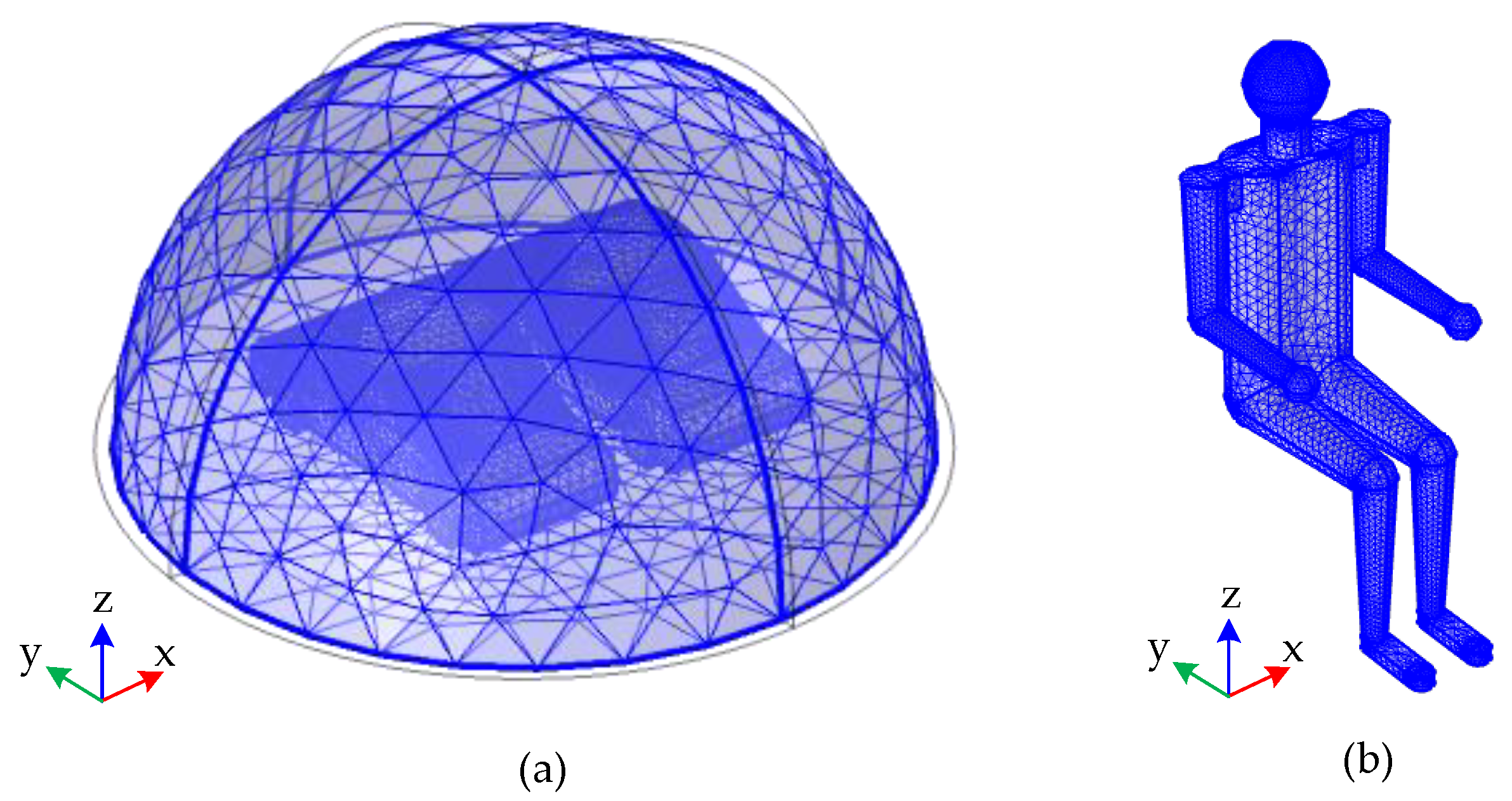
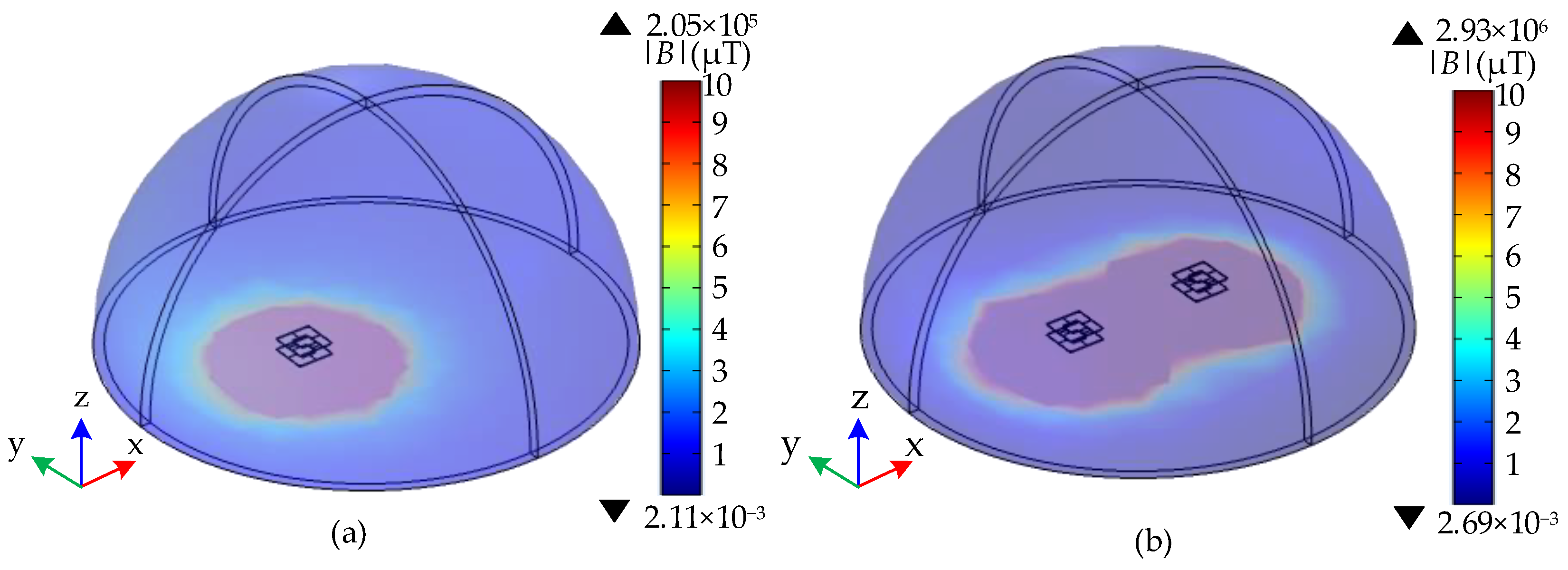
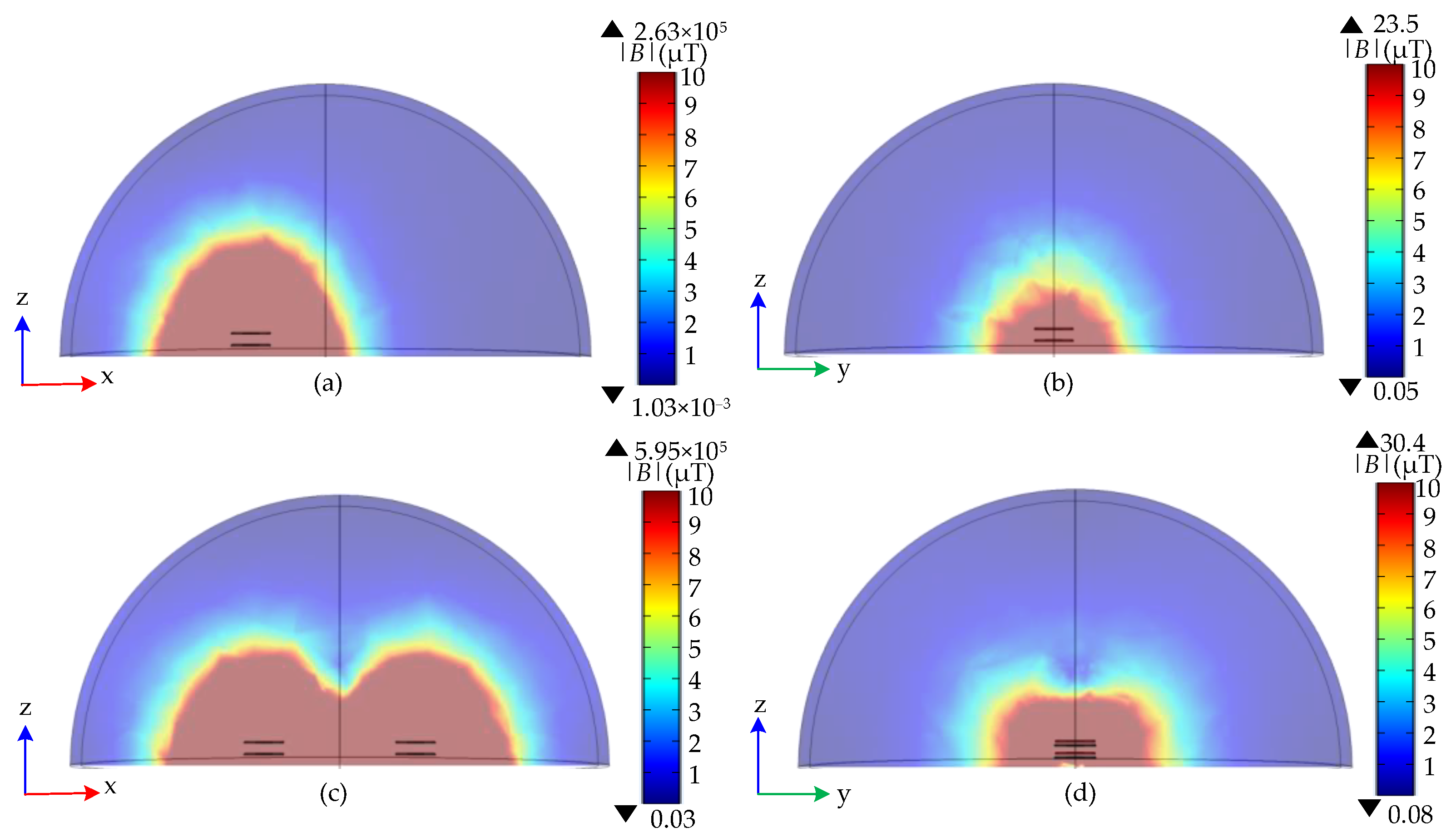

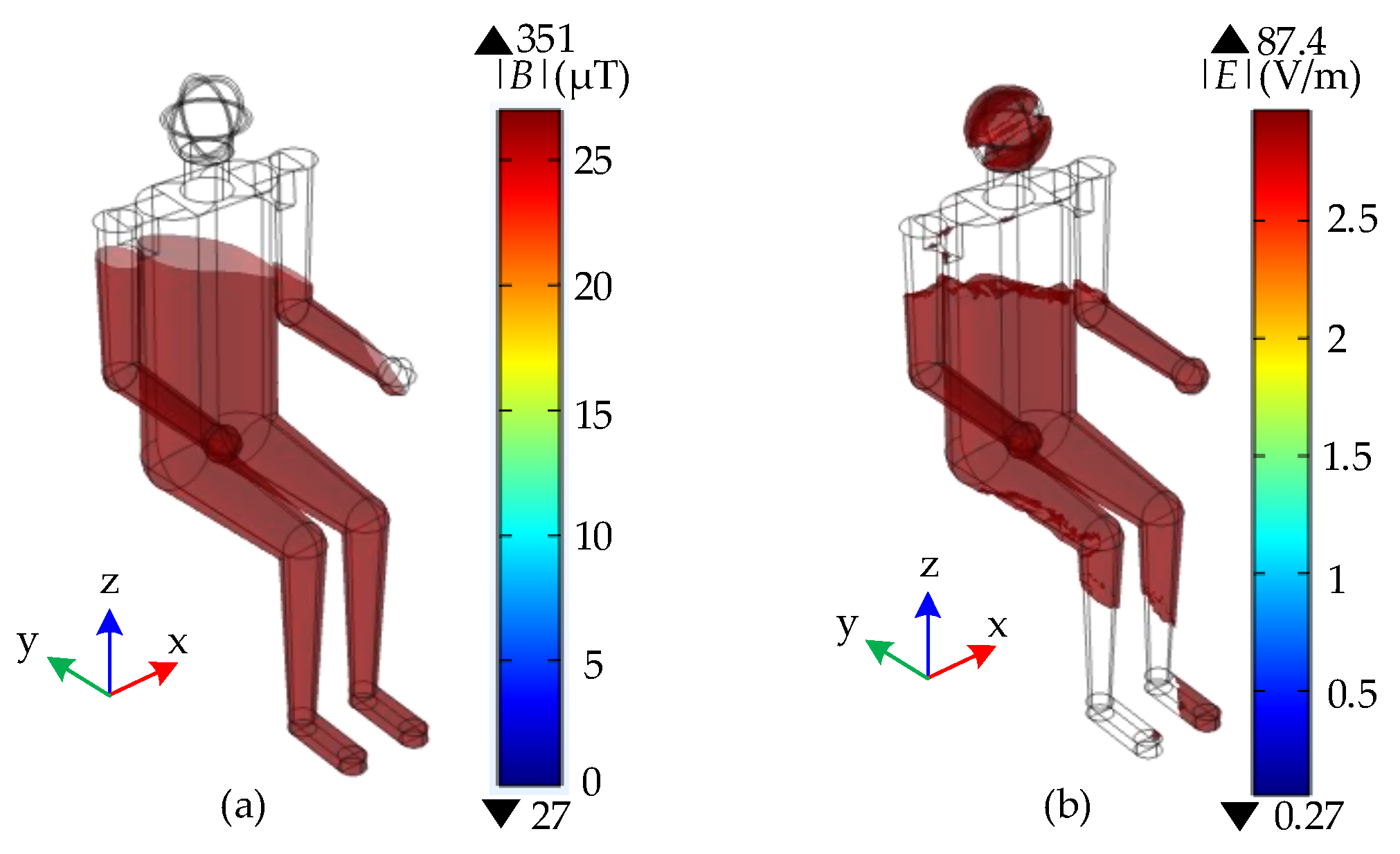
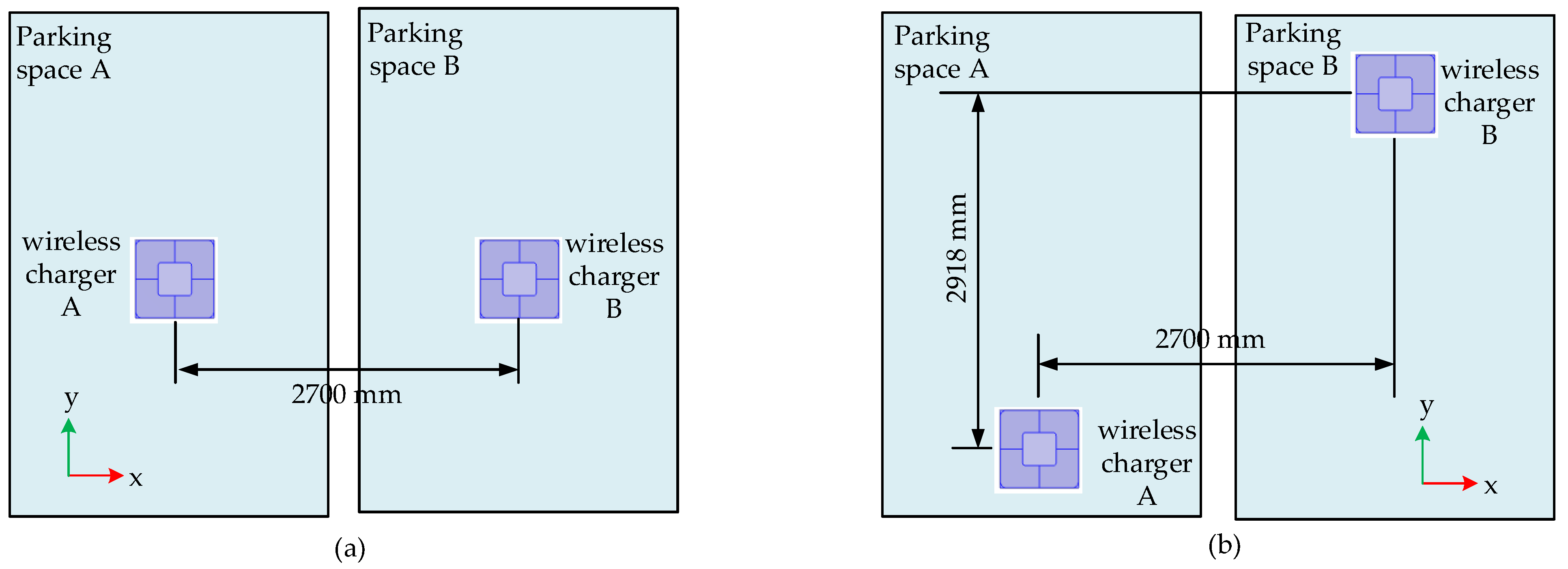
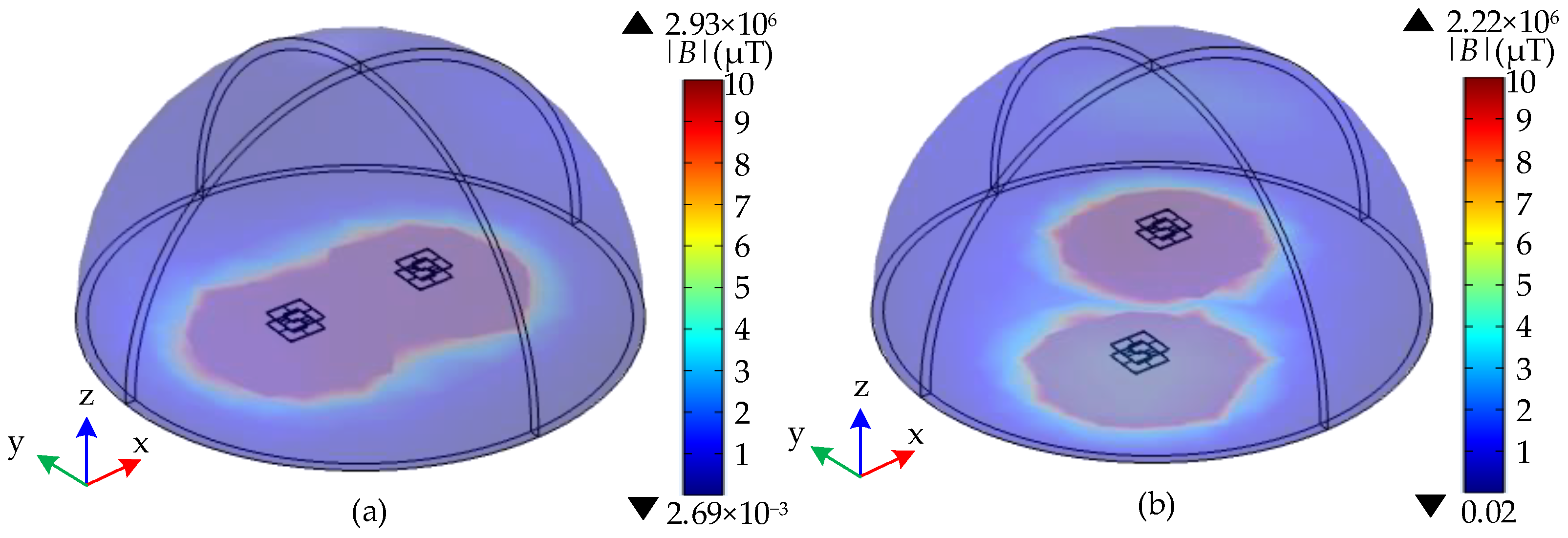
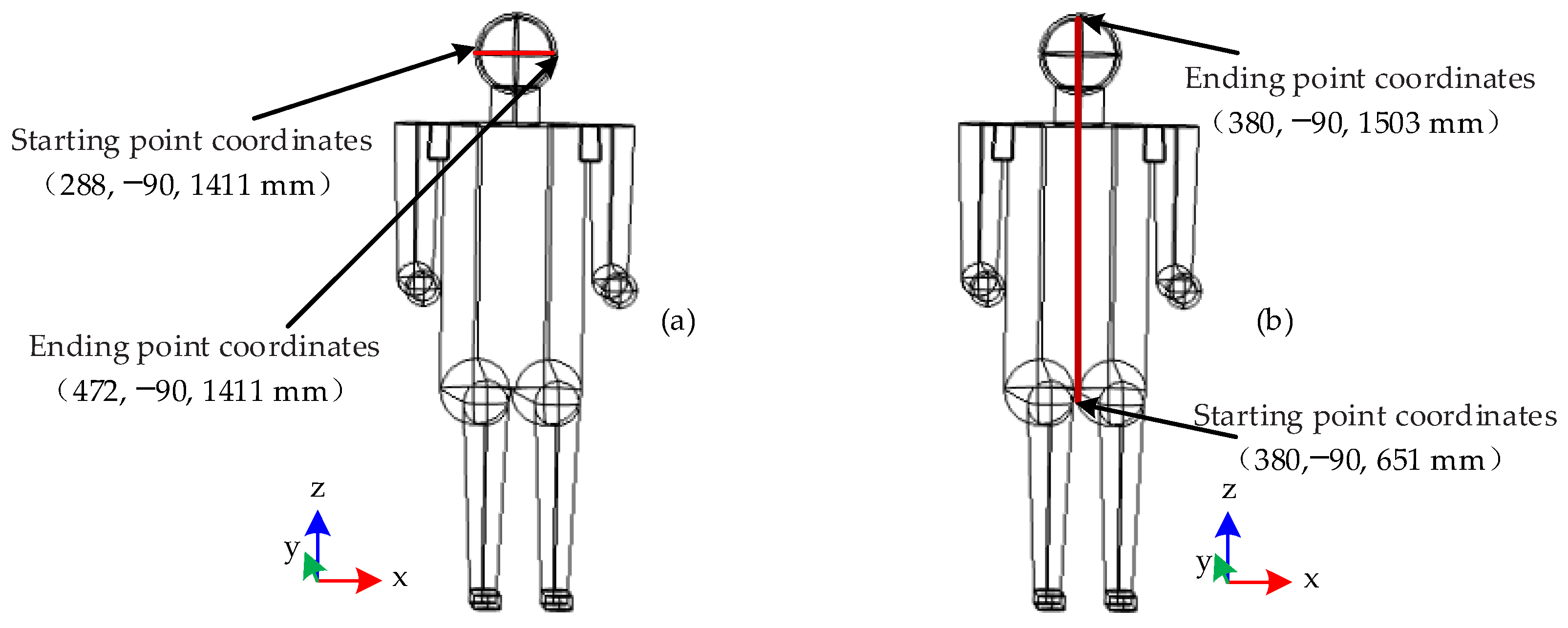

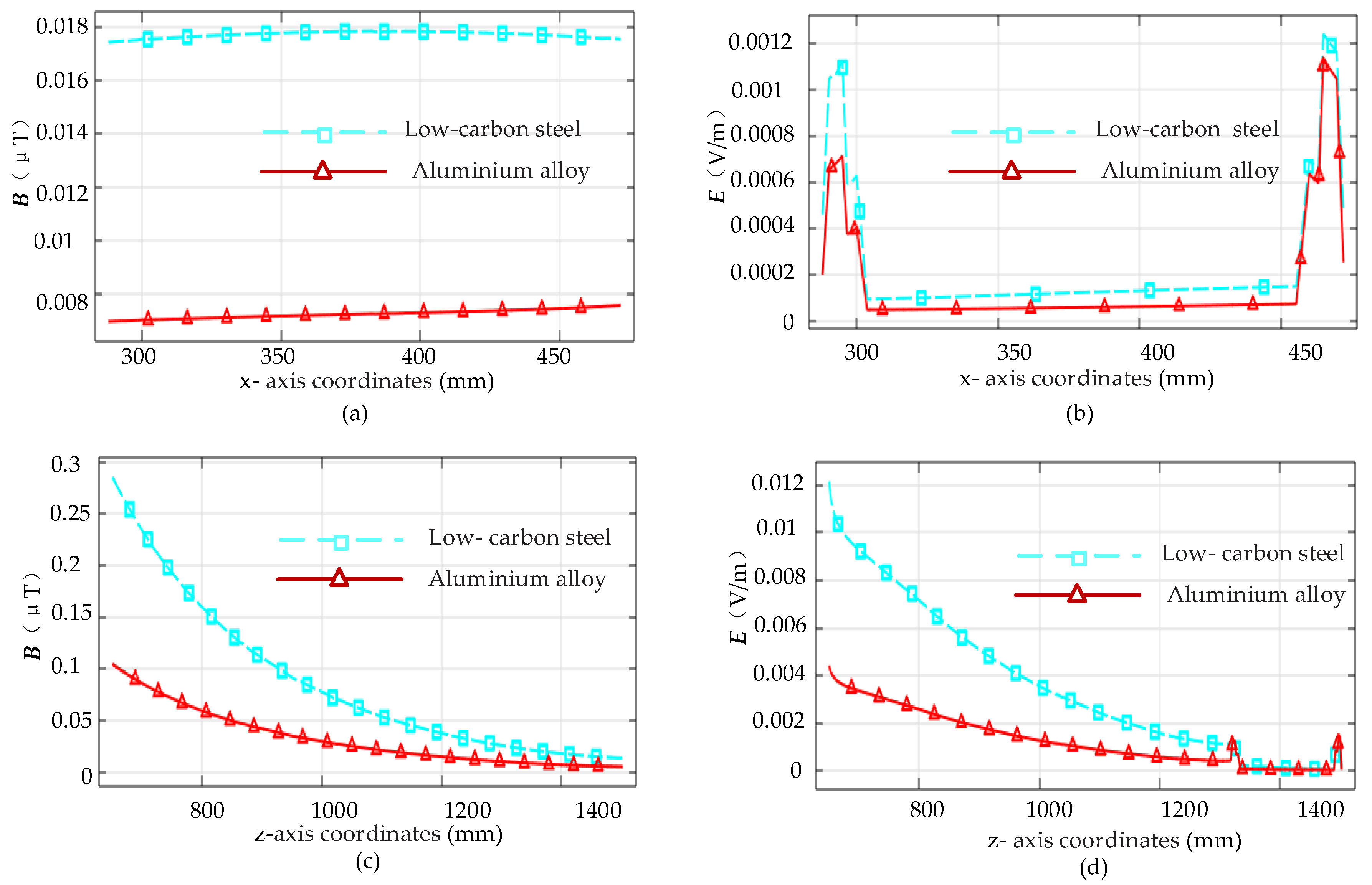
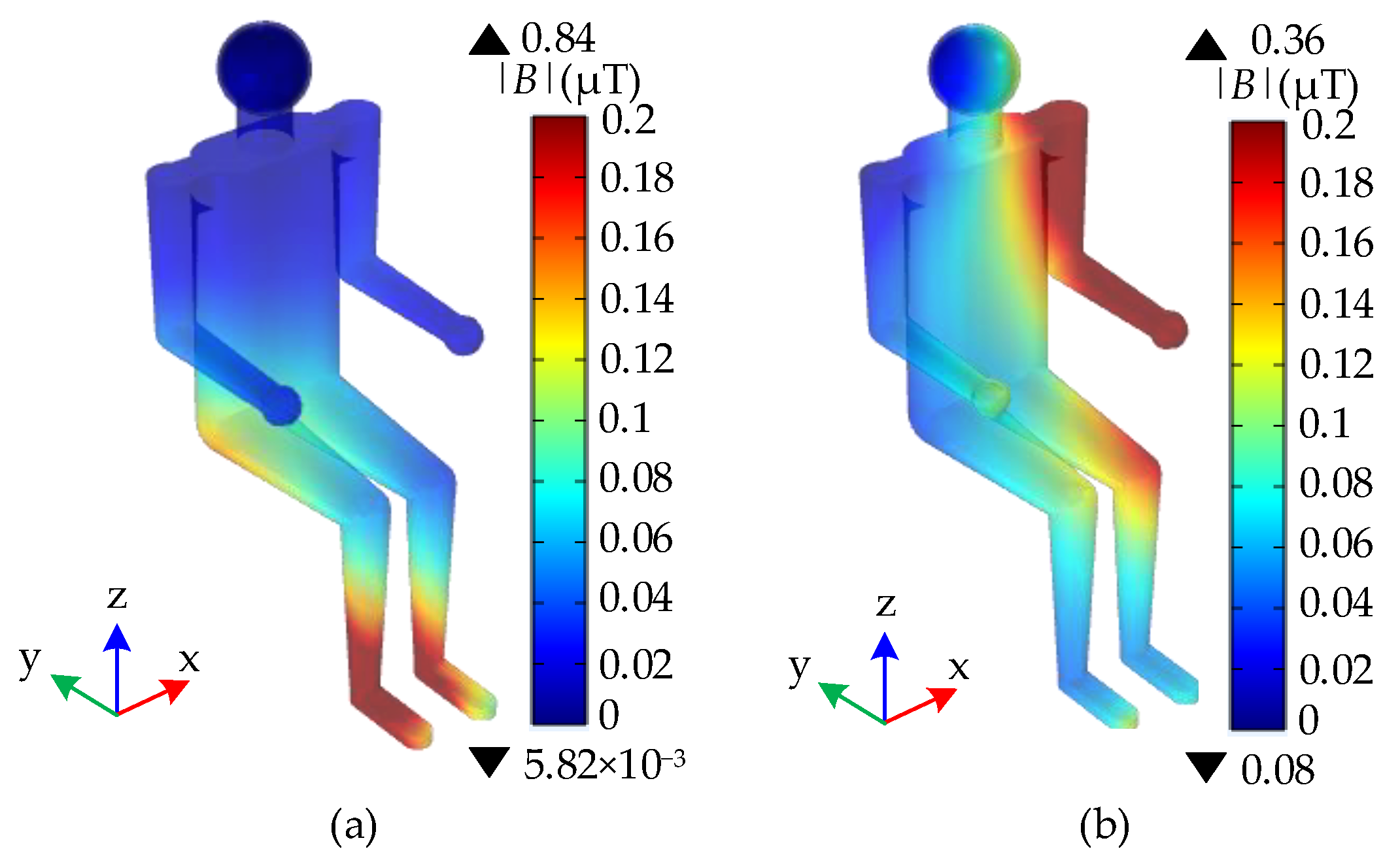
| Parameters | Numerical Value |
|---|---|
| Ferrite plate size (length × width × height)/mm × mm × mm | 700 × 700 × 3 |
| Air gap/mm | 190 |
| Resonant frequency/kHz | 22 |
| Transmitting power/kW | 21.88 |
| Receiving power/kW | 21.62 |
| Transmission efficiency (%) | 98.80 |
| Car Body and Window | Relative Permittivity | Conductivity (S/m) | Relative Permeability |
|---|---|---|---|
| Aluminum alloy | 1.0 | 2.33 × 107 | 1 |
| Low carbon steel | 1.0 | 8.41 × 106 | 150 |
| Carbon fiber | 1.0 | 2.50 × 105 | 1 |
| Glass | 5.5 | 1.0 | 1 |
| Tissues | Relative Permittivity | Conductivity (S/m) |
|---|---|---|
| Cerebral white matter | 6.73 × 103 | 7.32 × 10−2 |
| Cerebral gray matter | 1.09 × 104 | 1.21 × 10−1 |
| Cerebrospinal Fluid | 1.09 × 102 | 2.00 × 100 |
| Blood | 5.23 × 103 | 7.00 × 10−1 |
| Muscle | 1.47 × 104 | 3.45 × 10−1 |
| Bone | 5.47 × 102 | 3.55 × 10−2 |
| Skin | 1.40 × 104 | 4.63 × 10−3 |
| Different Positions | Two Chargers Work Simultaneously B (μT) | Charger A Works Alone B (μT) | Two Chargers Work Simultaneously/Charger A Works Alone (Multiple) |
|---|---|---|---|
| Simulation space | 2.93 × 106 | 2.05 × 105 | 143 |
| The zx section | 5.95 × 105 | 2.63 × 105 | 2.24 |
| The zy section | 3.04 × 101 | 2.35 × 101 | 1.29 |
| Inside the car A | 1.57 × 103 | 1.21 × 103 | 1.30 |
| Different Measures | Magnetic Induction Strength on Human Body Surface |B| (µT) | ICNIRP Exposure Limits |B| (µT) [25] | Percentage Values |
|---|---|---|---|
| No car body (the two chargers side by side) | 351 | 27 | 1300% |
| Aluminum alloy car body (the two chargers side by side) | 0.84 | 27 | 3.11% |
| Aluminum alloy car body (the two chargers are staggered) | 0.36 | 27 | 1.33% |
Publisher’s Note: MDPI stays neutral with regard to jurisdictional claims in published maps and institutional affiliations. |
© 2022 by the authors. Licensee MDPI, Basel, Switzerland. This article is an open access article distributed under the terms and conditions of the Creative Commons Attribution (CC BY) license (https://creativecommons.org/licenses/by/4.0/).
Share and Cite
Mou, W.; Lu, M. Research on Electric Vehicle Electromagnetic Protection Considering Radiation of Two Wireless Chargers. World Electr. Veh. J. 2022, 13, 95. https://doi.org/10.3390/wevj13060095
Mou W, Lu M. Research on Electric Vehicle Electromagnetic Protection Considering Radiation of Two Wireless Chargers. World Electric Vehicle Journal. 2022; 13(6):95. https://doi.org/10.3390/wevj13060095
Chicago/Turabian StyleMou, Wenting, and Mai Lu. 2022. "Research on Electric Vehicle Electromagnetic Protection Considering Radiation of Two Wireless Chargers" World Electric Vehicle Journal 13, no. 6: 95. https://doi.org/10.3390/wevj13060095
APA StyleMou, W., & Lu, M. (2022). Research on Electric Vehicle Electromagnetic Protection Considering Radiation of Two Wireless Chargers. World Electric Vehicle Journal, 13(6), 95. https://doi.org/10.3390/wevj13060095





